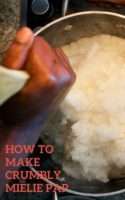There is something primeval about mielie pap. Well, there is something ancient and basic and satisfying about all starches that serve as the backbone of meals in cultures around the world. That which accompanies whatever sauce or stew or condiment being served in most ordinary homes, is what fills the tummy and leaves you with the feeling of well-being that gives you krag to start the day, or allows you to retire contented, with a full tummy, before bedtime.
While people are becoming more and more aware of the importance and food value of nutrient-dense protein and healthy fats and their contribution to feelings of satiation, over the ages, in most cultures, and at most times, it is the starchy component of the meal that ensures the diner leaves contented.
I am a Cape Town girl, and the first time I went to work away from home, I went to big-city Johannesburg. Along with the memories of freedom and adventure that move entailed, an enduring one is my first acquaintance with stywe or krummel pap. The cooperation I worked for had a staff canteen where everyone enthusiastically went for their lunches. When I arrived it was winter and there were a variety of stews on offer, served primarily with stywe pap – the preferred staple for most South Africans, but not in my family on the Cape Flats, where rice was the grain that soaked up the sauce in our plates.
When I did eat mielie pap as a child, it was cooked to a soft consistency for breakfast and served with milk and sugar. Sometimes my mom added some cardamom pods, which teased the taste buds and turned the meal into a dessert – add eggs to this mixture and bake instead of cooking on the stovetop, and it really is a full-on pudding.
But pap as an accompaniment to something savoury was what I really came to appreciate. I realised that it was above all the different texture of the pap when served like this that I liked. I also learned that while you can use the ordinary, more refined mielie meal, you also get a braai meal – which has a larger grain – which worked best at achieving the dry crumbly texture I enjoyed.
In my home, my husband makes the sauce and I make the pap because I am most particular about how I want it and nobody wants to be bothered with my complaints about it being too soggy! So here is my recipe for making the perfect krummel pap.
Method
Serves 4.
Overnight soak in a pot two cups of mielie meal in two cups of water. This shortens the cooking time and improves the texture and digestibility of the pap.
On medium heat bring the mixture to a bubble, stirring until all the water has been absorbed.
Add salt to taste, and turn the heat to low to allow it to simmer, stirring occasionally so that the mixture does not burn or stick to the bottom of the pot.
Add a little more water or a little more mielie meal to achieve the texture you prefer. It is important not to rush the cooking. Do not believe the cooking time on the packets the mielie meal comes in. Inevitably it takes a little longer to get it to the perfect texture – properly cooked but crumbly; the grains should be a little loose.
Gently agitate it with a fork just before serving so that it is fluffy and light.
A good tip is to start cooking your mielie pap well before the sauce is begun so that you are not tempted to rush it.
And it does not spoil by being served cold. In fact the texture improves. Properly done it should be malleable enough for you to be able to eat with your hands, when it becomes a utensil with which you scoop up your sauce! Enjoy.
Tell us: Which version of pap do you prefer, and what is your best way of making it? Who in your household prepares pap best?



